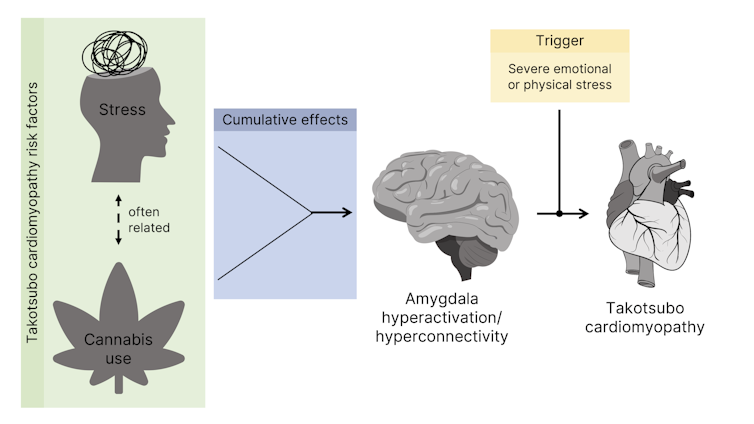
Kristen Yeh, University of Toronto
Non-medical cannabis has been legal in Canada since 2018. Although a primary motivation for legalization was to enhance public awareness of the health risks associated with cannabis use, the Canadian government’s online resources regarding cannabis harms may not reveal the full picture.
Well-known health impacts of cannabis use include respiratory issues, decreased cognitive ability, psychosis and risk of future substance use.
Recently, cannabis dependence has been identified as a risk for users of all ages. Approximately one in 10 adults and one in six adolescents who experiment with cannabis will become dependent. The risk increases to one in two for daily users.
Chronic use refers to weekly or more frequent cannabis use over a period of months or years. Chronic cannabis users are at risk of more severe and less frequently discussed health consequences. Examples include cannabinoid hyperemesis syndrome (CHS) and Takotsubo cardiomyopathy (TTC).
These conditions are rarely mentioned in the media. They are also absent from Canada’s online consumer resources on cannabis, despite their potential to be debilitating and, in some cases, fatal. More research is required to gauge the incidence rates of these conditions.
Cannabinoid hyperemesis syndrome
Cannabinoid hyperemesis syndrome, first defined in 2004, refers to cyclical vomiting experienced by chronic cannabis users (“emesis” means vomiting). People who have CHS can exhibit reoccurring episodes of nausea, vomiting, abdominal pain and dehydration, sometimes requiring hospitalization.
CHS is typically divided into three stages. In the first, prodromal phase, an individual starts to negatively react to cannabis, but vomiting has not begun. Symptoms include nausea, abdominal pain, heavy indigestion and lack of appetite. This initial phase can last for months to years, during which most affected people maintain normal eating habits.
Next is the hyperemetic phase, characterized by cyclic vomiting or “hyperemetic episodes.” Patients report intense and overwhelming vomiting during this phase. Some find that hot showers or baths temporarily ease their nausea.
The hyperemetic phase continues until the individual stops using cannabis. Once cannabis use has ceased, the recovery phase starts.
Currently, the most informative online resources regarding CHS are hosted on Reddit, in threads such as r/CHSinfo. While cases of CHS are not well-documented, evidence suggests that the commercialization of the cannabis market led to an increase in CHS-related emergency department visits. Increased public awareness of CHS could help address these trends.
Takotsubo cardiomyopathy
Takotsubo cardiomyopathy, also known as “broken heart syndrome,” is an acute reversible heart failure condition characterized by the weakening of the heart’s left ventricle, often caused by severe emotional or physical stress. “Takotsubo” refers to the apical ballooning shape in TTC, which resembles Japanese octopus traps.
Although originally believed to be a benign condition, there is a substantial risk of mortality with TTC.

TTC is most common in post-menopausal women, however, studies have suggested a link between chronic cannabis use and TTC in younger individuals. Incidents of TTC in cannabis users are associated with serious illness including stroke and cardiac arrest, even though these patients usually have more favourable cardiac risk factor profiles compared to older, non-cannabis using patients.
While the interplay between chronic cannabis use and TTC remains unclear, researchers have hypothesized cannabis use and stress have similar hyperactivation effects on the amygdala, a structure located in the brain’s temporal lobe. Excessive activation of the amygdala and the sympathetic nervous system is believed to be a dominant contributor to TTC.
The cost of chronic cannabis use
Although I research cannabis, I was unaware of TTC and CHS until I heard Liv Wilder’s story in episode 135 of the This Is Actually Happening podcast. I reached out to Wilder, who lives in the United States, to ask about his experience with cannabis and these conditions, which he also discusses on Instagram.
When Wilder was introduced to cannabis at age 20, he found a new sense of peace after struggling with anxiety and alienation since childhood. He began using cannabis daily.
After several months, he began experiencing intense nausea and vomiting that would last for hours. Some episodes required emergency room visits, where he received intravenous anti-nausea medication, but no clear diagnosis.
When Wilder switched from dried flower to concentrates, colloquially known as “dabs,” the higher dose of cannabinoids increased the frequency of his nausea and vomiting. Over the next two years of cannabis use, his nausea and vomiting became increasingly tortuous.
After a minor, unrelated surgical procedure performed under general anesthesia, Wilder breathed vomit into his lungs during recovery, turned blue and was rushed to emergency.
The apex of his heart had ballooned due to the stress of the anesthesia, years of chronic cannabis use and persistent vomiting. He was put on dialysis and life support, which led to a blockage in his right femoral artery, resulting in his foot becoming necrotic. His leg was amputated while he remained in a coma.
He woke up some time after his surgery as an above-the-knee amputee. Three years of chronic cannabis use had cost him his right leg.
Wilder was diagnosed with TTC, CHS, acute kidney injury and neuropathy in his left foot. He struggled with cannabis and alcohol abuse for 18 months following his amputation, but has abstained from both since July 2019. He is now very active in the gym, and loves rock climbing and camping.
Improving cannabis education
At present, occurrence rates of CHS and TTC in Canada remain unclear. According to the 2022 Canadian Cannabis Survey, one in five Canadian cannabis users reported daily use in the past year. CHS has been estimated to affect one of every 200 daily cannabis users. Associations between TTC and chronic cannabis use are not as well understood.
Providing consumers with a regulated source of cannabis that is not synthetic, contaminated with pesticides, or laced with other drugs is necessary. As a scientist who studies cannabis emissions, I am an avid supporter of legalization. Nonetheless, commercialization of the market without sufficient cannabis education contradicts the goal of the Cannabis Act: to protect the public health and safety of Canadians.
Now that Canada’s federal review of the impacts of legalization is underway, it is essential to highlight chronic cannabis use and associated health risks. The government has an obligation to ensure that information about the health risks of cannabis use is as equally accessible to the public as cannabis products have become.![]()
Kristen Yeh, PhD Candidate, Environmental Chemistry, University of Toronto
This article is republished from The Conversation under a Creative Commons license. Read the original article.

